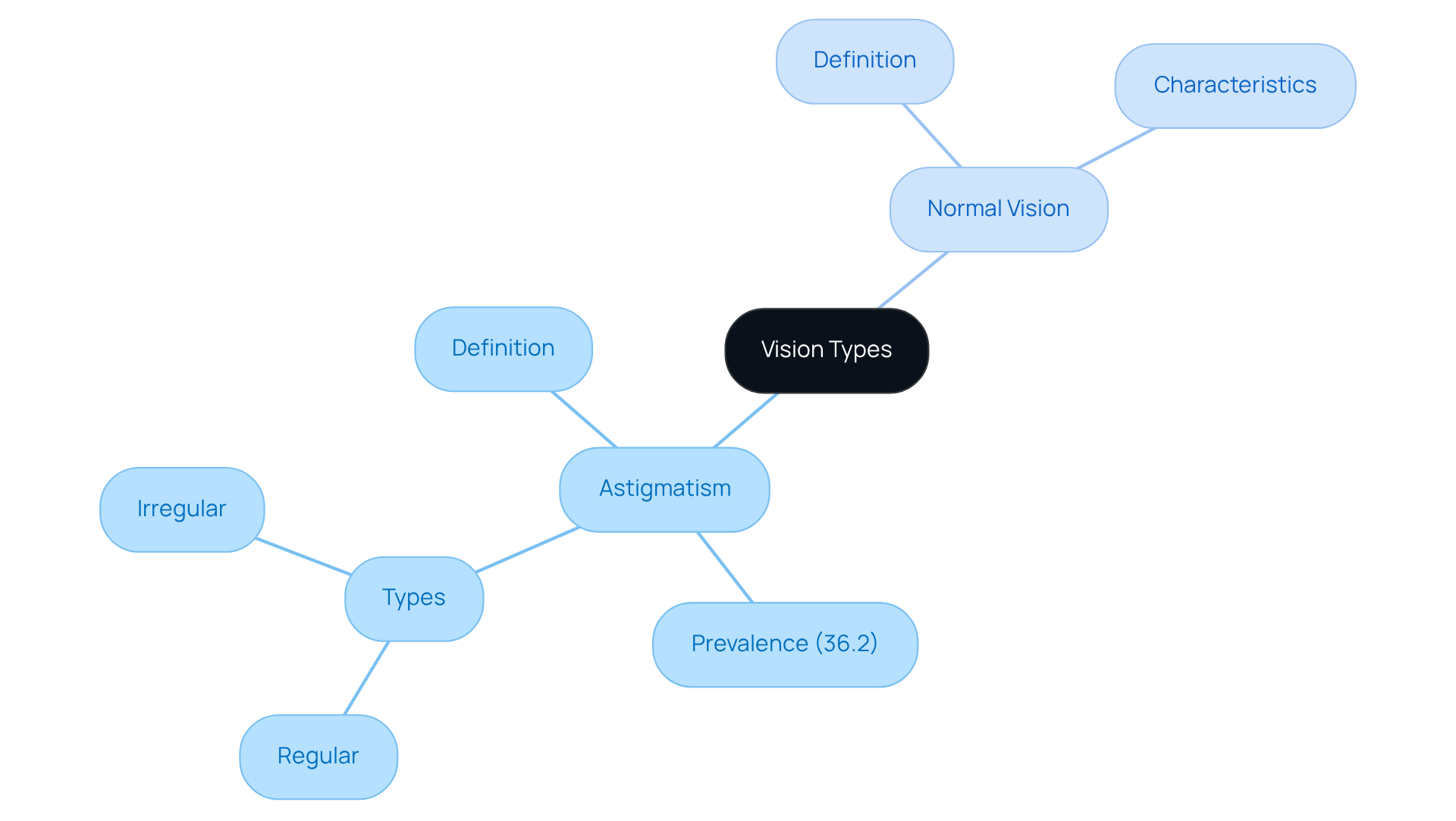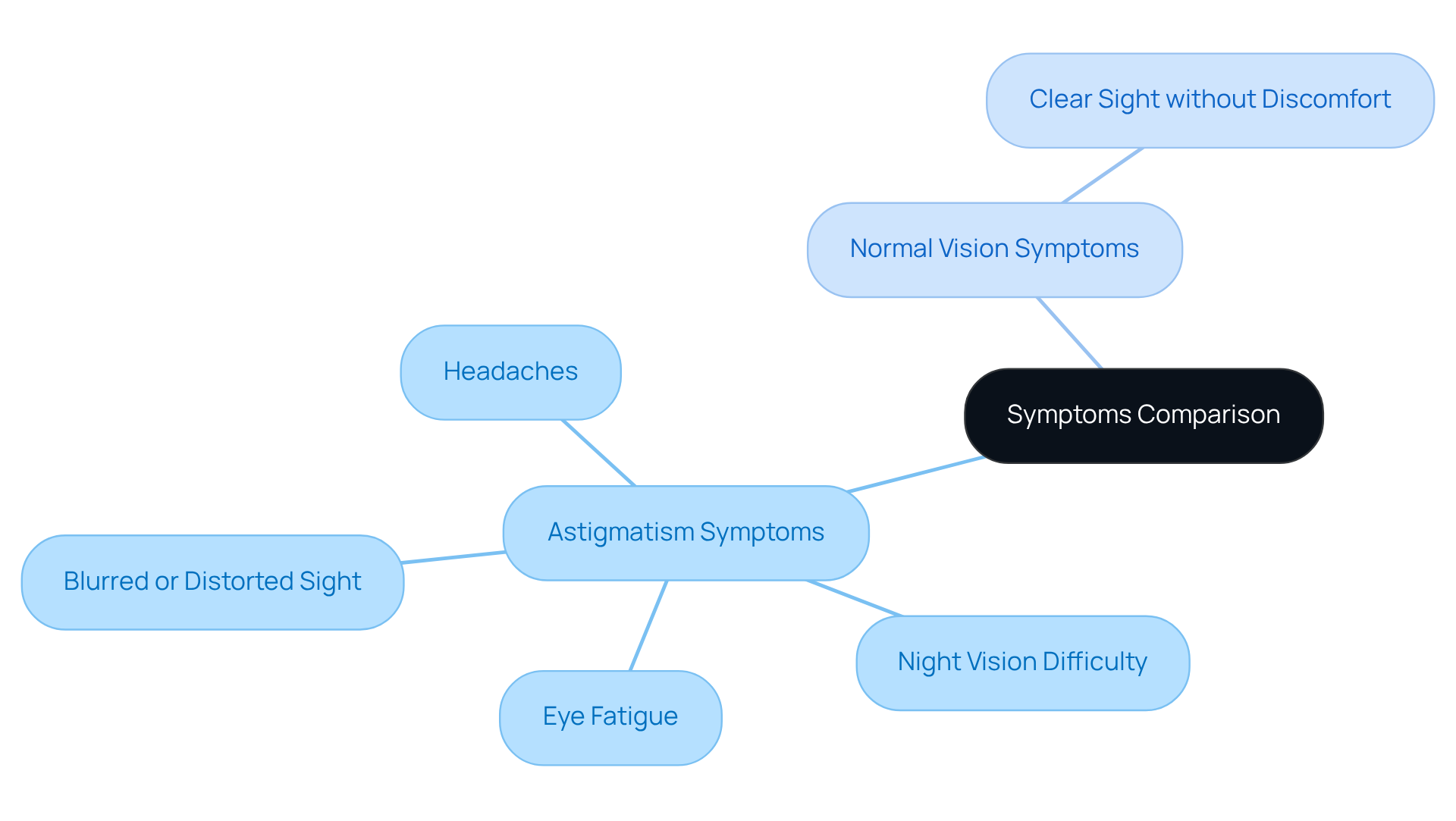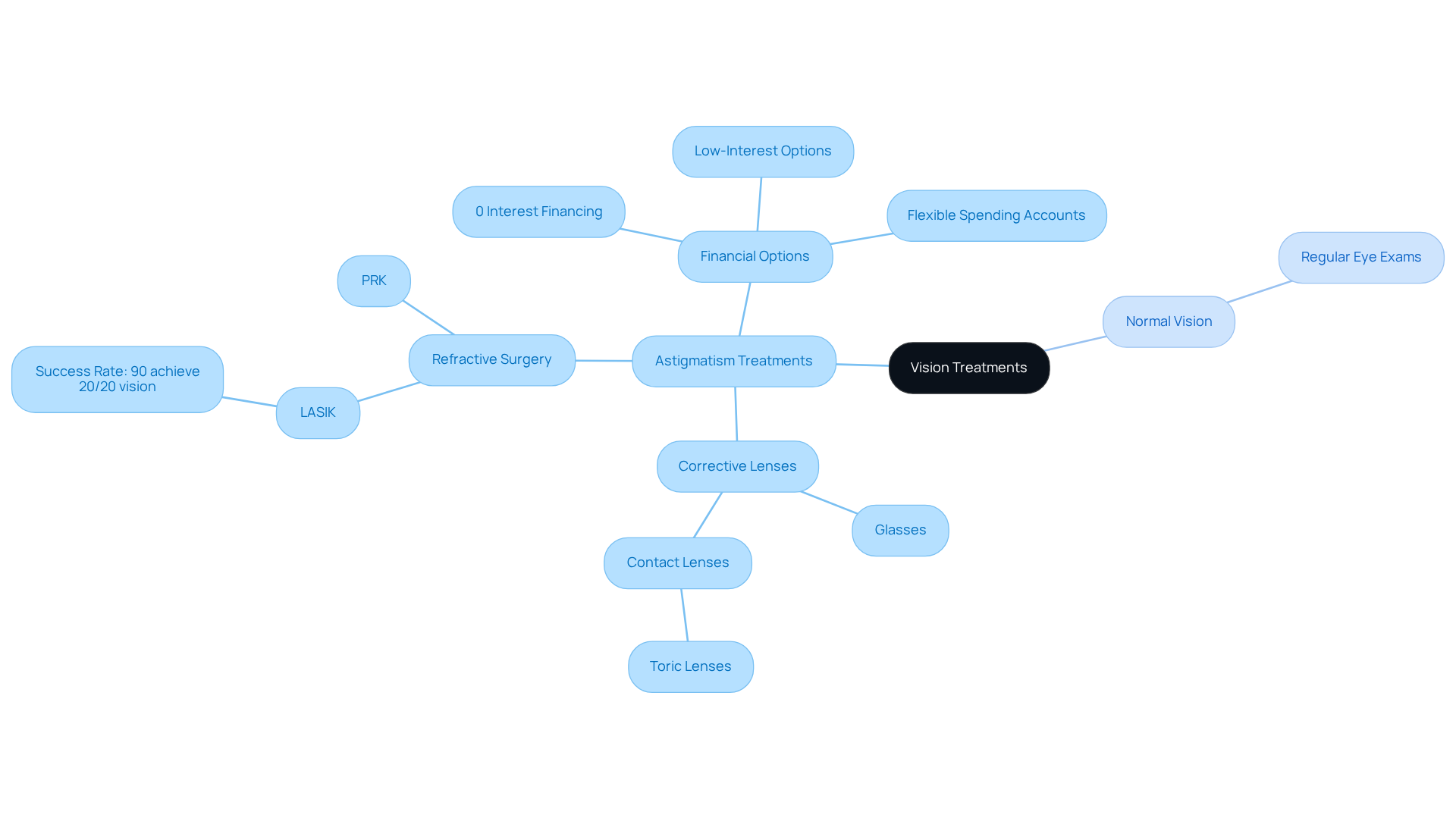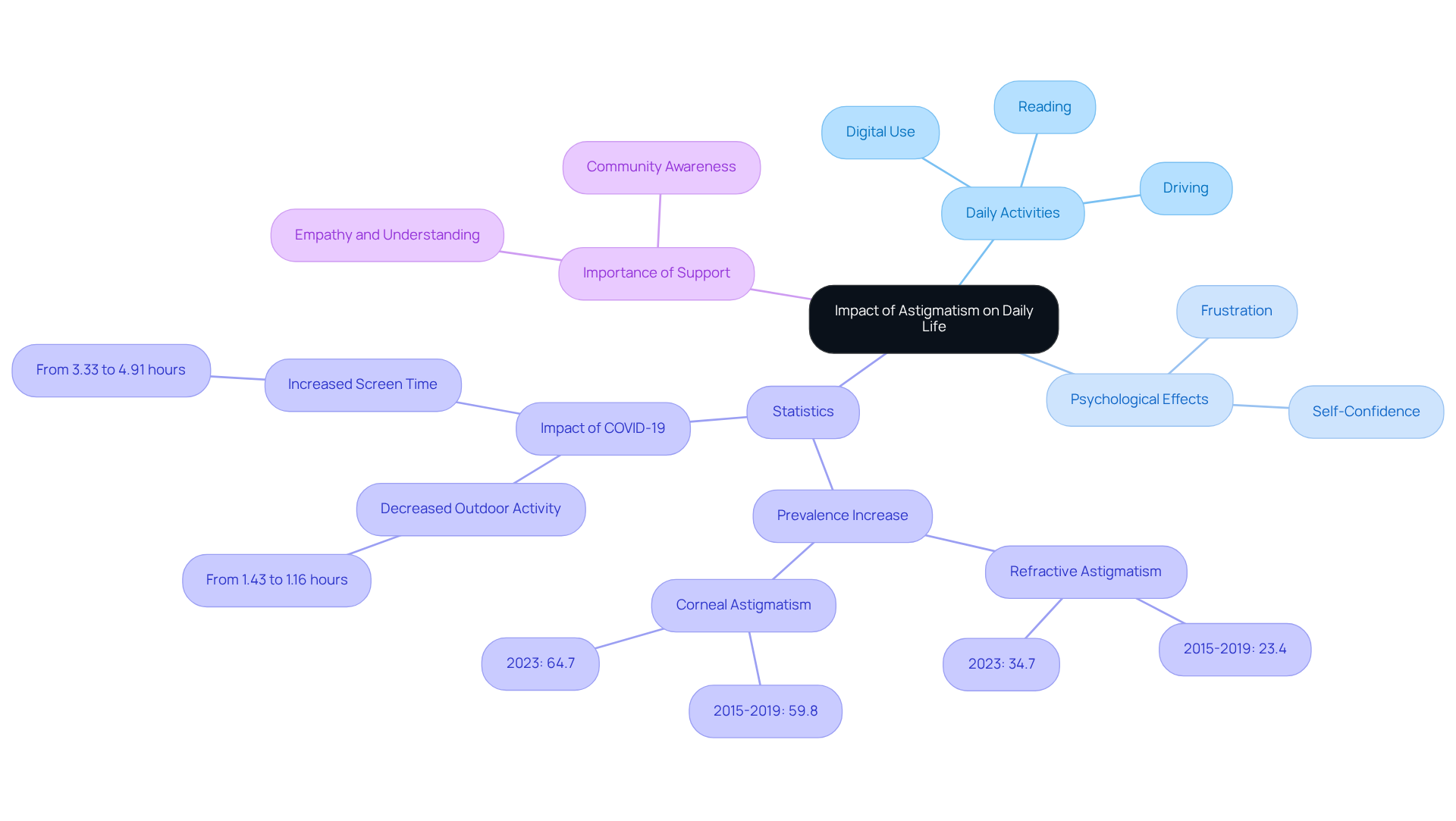Posted by: Northwest Eye in Astigmatism on October 23, 2025
Overview
Astigmatism differs from normal vision primarily in how light is focused on the retina. This difference can lead to blurred or distorted sight, which can be frustrating and disheartening for those affected. In contrast, normal vision allows for clear and sharp images, making daily activities much easier.
We understand that living with astigmatism can impact your quality of life. The article emphasizes how this condition affects daily activities, highlighting the importance of corrective measures. Whether through glasses or surgery, these options can significantly alleviate the challenges faced by individuals with astigmatism.
It’s common to feel overwhelmed by these challenges, but know that there are effective solutions available to help you regain clarity in your vision. We are here to help you through this process, ensuring you have the support you need to make informed decisions about your eye care.
Introduction
Astigmatism affects a significant portion of the population, leading to a range of visual distortions that can complicate everyday activities. We understand that living with astigmatism can be challenging. While normal vision allows light to focus directly on the retina, creating clear images, astigmatism results from an irregular curvature of the cornea or lens, causing blurriness and discomfort.
It’s common to feel frustrated by these vision differences. This contrast raises important questions about how astigmatism truly impacts daily life and what can be done to mitigate its effects. Understanding these nuances is essential for anyone navigating the complexities of vision care. We are here to help you through this process.
Define Astigmatism and Normal Vision
Astigmatism is a common refractive error that many people experience. It is defined by an irregular curvature of the cornea or lens, which can lead to distortion or blurriness at all distances. We understand that this can be concerning, especially when it affects your daily activities, such as reading, driving, or recognizing faces. In contrast, the comparison of astigmatism lights vs normal vision, known as emmetropia, occurs when light rays focus directly on the retina, producing clear and sharp images.
Approximately 36.2% of individuals experience some form of vision distortion, which can significantly impact their quality of life. Astigmatism is classified into two primary types:
- Regular
- Irregular
Regular corneal distortion has a consistent curvature, while irregular corneal distortion exhibits varying curvatures and is often linked with conditions such as keratoconus. Understanding these distinctions is crucial for recognizing how they influence overall quality of life and the necessity for corrective measures.
It’s common to feel uncertain about what this means for your vision. We are here to help you through this process and provide the support you need. If you have any questions or concerns, please don’t hesitate to reach out.

Compare Symptoms of Astigmatism and Normal Vision
People with irregular corneas often describe experiencing blurred or distorted sight, difficulty seeing at night, eye fatigue, and headaches. We understand that these symptoms can range from mild to severe, often worsening with extended visual tasks, which can make everyday activities challenging. In contrast, individuals with normal vision typically enjoy clear sight without discomfort, allowing them to engage in activities without the visual strain associated with refractive errors.
Identifying these signs is crucial for prompt diagnosis and action. It’s common to feel overwhelmed by untreated vision issues, which can lead to complications such as amblyopia, especially in children. The stark contrast in symptoms highlights the necessity of regular comprehensive eye examinations. These check-ups are essential for maintaining optimal eye health and ensuring timely corrective measures.
We are here to help you through this process, emphasizing the importance of seeking care to address your concerns.

Contrast Treatments for Astigmatism and Normal Vision
Treatment for astigmatism primarily involves corrective lenses, such as glasses or contact lenses, specifically designed to address the cornea’s irregular curvature. We understand that navigating vision issues can be challenging, and toric lenses are commonly used for their efficacy in delivering clear sight. For those seeking a more permanent solution, refractive surgeries like LASIK and PRK are viable options. These procedures reshape the cornea, allowing light to focus accurately on the retina, significantly improving visual clarity. Research shows that around 90% of patients undergoing LASIK attain 20/20 eyesight or better within a year after surgery, highlighting the high success rates linked to these procedures.
For individuals with typical eyesight, no treatment is necessary, although regular eye exams remain crucial for maintaining eye health. It’s common to feel uncertain about the right course of action, and this difference in treatment methods underscores the significance of tailored care in managing vision issues. Eye care professionals emphasize that understanding the distinct features of one’s vision condition is vital in evaluating LASIK eligibility. As advancements in technology continue to evolve, the landscape of eye condition treatment is becoming increasingly promising, with emerging therapies offering safer and more effective alternatives to traditional methods.
At Northwest Eye, we recognize that financial considerations are an important aspect of your treatment journey. We offer financing options for LASIK and premium IOLs, including:
- 0% interest financing for up to 24 months through CareCredit
- Low-interest options for up to 60 months, with payments as low as $100 per month
This flexibility allows you to maximize your savings and make informed decisions about your eye care. By alleviating financial stress, these options enable you to focus on achieving optimal visual outcomes. Additionally, utilizing flexible spending accounts can further enhance your financial planning for these procedures.

Evaluate the Impact of Astigmatism on Daily Life
The effects of astigmatism lights vs normal can significantly impact everyday tasks, especially in activities like reading, driving, and using digital devices. We understand that individuals with this refractive error, specifically astigmatism lights vs normal, often encounter unclear vision, leading them to squint or strain their eyes in an effort to achieve sharper clarity. This constant effort can result in considerable eye fatigue and discomfort, making even simple tasks feel laborious. In contrast, those with normal vision, as compared to those experiencing astigmatism lights vs normal, can engage in these activities effortlessly, without the burden of visual strain.
Recent studies highlight the broader effects of this vision condition on quality of life. For instance, the occurrence of refractive vision distortion among children has risen, with rates climbing from 23.4% in 2015-2019 to 34.7% by 2023. This increase is linked to lifestyle changes during the COVID-19 pandemic, where screen time surged from 3.33 hours to 4.91 hours daily, alongside decreased outdoor activity, leading to deteriorating eyesight. The psychological impacts of living with a refractive error can be significant, often manifesting as frustration and reduced self-confidence. Dr. Liji Thomas notes, “Since this condition disrupts both close and far sight, it can elevate the risk of amblyopia – often referred to as ‘lazy eye.'” It’s common for individuals to feel self-conscious about their vision, which can hinder social interactions and overall well-being.
Ophthalmologists emphasize that the difference between astigmatism lights vs normal not only disrupts visual clarity but can also affect daily activities, from reading fine print to driving safely. The emotional toll of managing this refractive error underscores the importance of understanding and addressing the challenges faced by those affected. By fostering empathy and support, we can better assist individuals navigating the complexities of astigmatism in their everyday lives.

Conclusion
Astigmatism presents a distinct challenge to visual clarity, contrasting sharply with the clear perception experienced by individuals with normal vision. This refractive error, characterized by an irregular curvature of the cornea or lens, can lead to significant difficulties in daily activities. We understand that recognizing the differences between astigmatism and normal vision is crucial for understanding its impact on quality of life and the importance of seeking appropriate corrective measures.
Throughout this article, we have explored key aspects of astigmatism, including its symptoms, treatment options, and the broader implications for daily living. Individuals with astigmatism often face blurred vision, eye strain, and discomfort, especially during tasks that require prolonged focus. In contrast, those with normal vision enjoy the ability to engage in activities without the burden of visual distortion. The examination of treatment options, from corrective lenses to advanced surgical procedures, highlights the importance of tailored care in managing this condition effectively.
Ultimately, recognizing the differences between astigmatism and normal vision is essential for fostering understanding and support for those affected. By prioritizing regular eye examinations and seeking appropriate interventions, individuals can significantly improve their visual experience and overall quality of life. It’s common to feel overwhelmed, but emphasizing the importance of proactive eye care not only aids in managing astigmatism but also enhances the well-being of those navigating the complexities of vision challenges. We are here to help you through this process.
Frequently Asked Questions
What is astigmatism?
Astigmatism is a common refractive error caused by an irregular curvature of the cornea or lens, leading to distortion or blurriness at all distances.
How does astigmatism affect daily activities?
Astigmatism can affect daily activities such as reading, driving, and recognizing faces due to the distortion or blurriness it causes in vision.
What is normal vision?
Normal vision, known as emmetropia, occurs when light rays focus directly on the retina, producing clear and sharp images.
What percentage of individuals experience some form of vision distortion?
Approximately 36.2% of individuals experience some form of vision distortion, which can significantly impact their quality of life.
What are the two primary types of astigmatism?
The two primary types of astigmatism are regular and irregular astigmatism.
What is the difference between regular and irregular astigmatism?
Regular astigmatism has a consistent curvature of the cornea, while irregular astigmatism exhibits varying curvatures and is often associated with conditions such as keratoconus.
Why is it important to understand the distinctions between types of astigmatism?
Understanding the distinctions between types of astigmatism is crucial for recognizing their impact on overall quality of life and the necessity for corrective measures.






